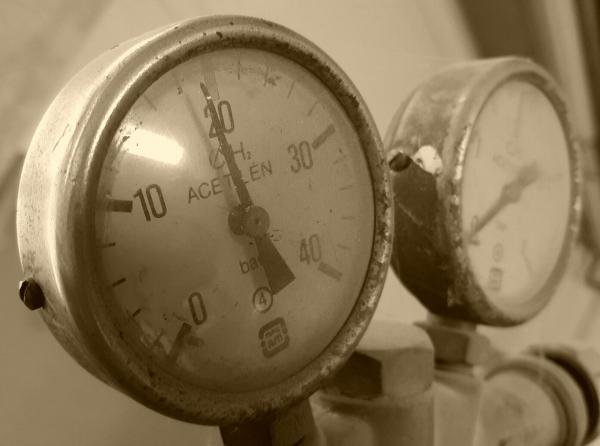Most commonly used in the fabrication industry, acetylene is used for a variety of applications, most commonly used in welding due to its heating ability. Compared to other gases, acetylene burns the hottest flame when combined with oxygen. With a peak temperature of 3150 degrees Celsius, this makes oxy-acetylene the hottest fuel gas making it the perfect gas for cutting and brazing steel.
Because of its quick burning speed, acetylene can become very unstable under heat, high pressures, and other conditions. Acetylene can also be explosive if the regulated pressure exceeds 15 psi (Pounds per Square Inch). Mixing acetylene with air, liquefying, compressing or heating the gas can also cause potential hazards. That’s why it’s important to be knowledgeable about how acetylene is stored, how to handle it and how to withdraw the gas properly for safe usage.
How Acetylene is Stored
Due to its highly reactive nature, acetylene is not stored like other compressed gases. Pure acetylene cannot be pressurized or else it would cause an explosion, which is why it can’t be stored like other compressed gases. The cylinders used to store acetylene contain a porous filler material that resembles pumice stone.
Liquid acetone is then added to the cylinder and the filler material serves its purpose of absorbing the liquid acetone and evenly distributing it throughout the cylinder to prevent any empty spaces from forming inside the cylinder. This helps reduce the likelihood of acetylene decomposition, which is a spontaneous chemical reaction that happens when acetylene breaks down into carbon and hydrogen and can potentially cause the gas to ignite.
The liquid acetone works as a solvent and also as a stabilizer. Acetylene is dissolved in the acetone to reduce the cylinder pressure and to keep the acetylene from reacting with oxygen. Since acetone can dissolve large amounts of acetylene, it allows more gas to be stored at a lower pressure safely.
Storing acetylene gas properly is very important in order to avoid any potential hazards or accidents, but operators should also be careful when dispensing the gas. This is where the 1/7th rule comes into play.
The 1/7th Rule
The 1/7th rule refers to the flow rate at which an operator dispenses the gas from the cylinder. For common uses like welding, cutting and allied processes it is recommended to flow no more than 1/7th of the cylinder’s total contents at a time at a regulated pressure that does not exceed 15 pounds per square inch.
The 1/7th rule has been the standard for many years, but was updated to 1/10th to further minimize the withdrawal of liquid solvent (see Compressed Gas Association G.1 5.3.3.13):
To minimize the withdrawal of liquid solvent, acetylene should be withdrawn from the cylinder at a rate not to exceed one-tenth (1/10) of the capacity of the cylinder per hour during intermittent use. For full withdrawal of the contents of the cylinder on a continuous basis, the flow rate should be no more than one-fifteenth (1/15) of the capacity of the cylinder per hour.
It’s very important to follow this rule of thumb in order to safely withdraw acetylene from the cylinder. If the flow rate exceeds the recommended flow rate, you’ll start to pull acetone through which can cause the acetylene to reduce. If acetylene reduction occurs, this can cause the acetylene to become very unstable and potentially explosive. Additionally, acetone damages plastic and rubber, so it can damage torches, regulators and the hose used to dispense the gas if the solvent passes through.
General Advice
The use of acetone with acetylene is an important process that allows for safer cylinder handling and usage. But, that doesn’t mean that you shouldn’t be extra careful when handling acetylene cylinders. Always make sure to handle cylinders with care and try not to bump or drop them. Always use acetylene cylinders in the upright position. If acetylene is transported horizontally, store it vertically for at least as long as it was in the horizontal position before using it. Also, remember to keep the cylinder away from direct heat and only use it in well-ventilated areas.
Now that you are aware of the standard flow rate rules, it’s important to follow the 1/10th rule when withdrawing gas from the cylinder and knowing whether or not that is going to sufficient enough for your project.
Before starting a job, evaluate how big your project actually is and the amount of gas you’ll need to accomplish it. For big, heavy-duty jobs, manifolding your acetylene cylinders will be required in order to withdraw the required amount of acetylene gas needed for your project.
Acetylene is a perfectly safe gas to use as long as you are knowledgeable of the potential dangers and hazards that can occur if not handled properly or misused. Here at Wagner Welding Supply we have a team of welding professionals that can assist you with acetylene gas orders or help you answer any potential questions around applications, use, and handling. For assistance, please contact us at (303) 776-1491 or get a free quote online.
Sources:
https://www.harrisproductsgroup.com/en/blog/2019/august/what-is-the-1-7-acetylene-rule.aspx
https://www.boconline.co.uk/en/images/Facts-about-acetylene_tcm410-262700.pdf
https://law.resource.org/pub/us/cfr/ibr/003/cga.g-1.2009.pdf
https://www.thefabricator.com/thewelder/article/safety/fuel-your-safety-knowledge

